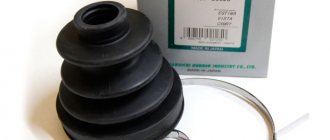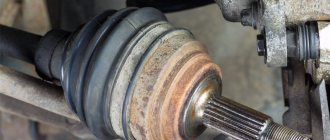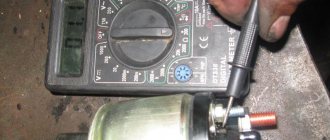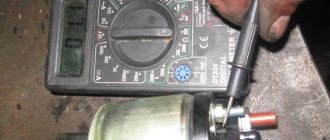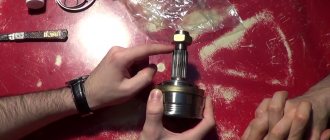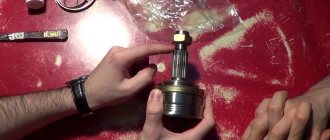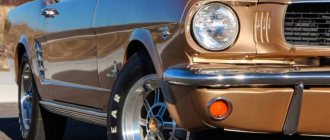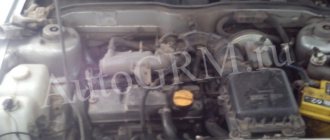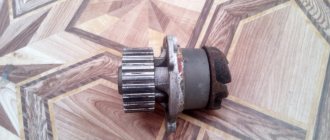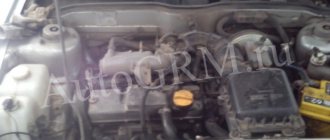The best manufacturers of CV joint boots
Each brand has an individual list of pros and cons that affect operation, as well as customer choice.
MARUICHI
Description. The Japanese company MARUICHI is considered one of the market leaders in the field of rubber-metal parts, which includes anthers. The brand is distinguished by proven quality, which is achieved by high-tech production and the use of durable materials.
We supply boots not only to the secondary market, but also to the assembly line, which allows customers to receive similar parts for their cars.
The boot is made of a rubber mixture, which has increased resistance to mechanical loads and frost resistance.
Spare parts can withstand temperatures down to -50 °C.
Equipment. The standard equipment includes the boot itself, good quality molybdenum grease, clamps, and a retaining ring. Often the kit also includes a hub nut.
Life time. The service life exceeds 3 years, with a guaranteed service life of 1 year.
Pros of MARUICHI
- High quality combined with a low price.
- Analogue to original spare parts for Japanese cars.
- Long-term operation due to wear resistance of rubber.
- Frost resistance, which is important for northern regions.
- Good packaging and inclusion of lubricant.
Cons of MARUICHI
- Narrow clamps.
- Some models supplied to the secondary market differ from the originals, which requires the correct selection of the optimal boot.
TRACK
Description. The domestic manufacturer TREC occupies a significant segment of the anther market in Russia. This is due to the introduction of innovations in production and high-quality products that have international quality certificates, including environmental ones.
The boot is made of high-strength polyurethane, which increases service life and resistance to mechanical damage. There are several series of anthers available on the market, differing in characteristics and configuration.
Equipment. The standard kit includes a boot, clamps and lubricant. In the classic series, only the boot is supplied.
Life time. The guaranteed service life is 12 months or 40,000 km. In practice, the actual duration of operation depends on operating conditions and compliance with all rules. The boot can protect the unit for more than 5 years if treated with care and appropriate maintenance.
Pros of TRACK
- In production, thermoplastic elastomer is used, created on a polyurethane basis, which increases the strength indicators relative to rubber three times.
- Resistance to temperatures ranging from -65°C to +110°C.
- They last a long time with proper installation and maintenance.
- Good price/quality ratio combined with a large selection.
- High quality durable stainless steel clamps.
Cons of TRACK
- It is difficult to select a boot with the required dimensions for a number of foreign cars, since the products are more aimed at the domestic market.
- There may be a defective batch under this brand, so it is worth checking the place of manufacture when purchasing.
HORSE
Description. The Russian company HORS is part of a diversified holding association that supplies spare parts to the secondary market. Rubber-metal products, including anthers, are considered one of the production lines.
The boot is made of silicone with a good level of frost resistance. This allows it to be used in northern regions.
The element retains elasticity at temperatures from - 50 C to + 250 C. Wear resistance, which is achieved through high-quality silicone, is taken into account. The difference is considered to be a good level of protection against any aggressive substances.
Equipment. The kit includes clamps, the cover itself and lubricant.
Life time. The guaranteed period is 1 year, but practice shows that the service life significantly exceeds 3 years with proper installation.
Pros of HORSE
- High-quality design with a seal at the clamp attachment point, which ensures structural strength and reduces the possibility of dirt penetration.
- Heat and frost resistance.
- Possibility of installation on domestic and foreign brands of cars.
- Long service even in difficult conditions.
Cons of HORSE
- There are low-quality copies in the form of fakes. They cost less than the originals.
SWAG
Description. SWAG's enterprises are located in Germany. Boots are among the aftermarket parts that are supplied to international markets. In the manufacture of spare parts, high-quality materials with increased resistance to damage, including mechanical damage, are used.
Despite the fact that the company supplies a number of models of anthers for assembly line assembly, the quality of the originals is much higher than the parts supplied to the secondary market. The difference will be a low price segment compared to competitors with European quality certificates.
Equipment. The kit includes a cover, clamps, lubricant, and may also include a retaining ring. Each series has its own equipment.
Life time. The warranty is issued for one calendar year. The duration of actual operation depends on many factors, but the average period exceeds two years.
Pros of SWAG
- Budget option with European quality.
- Large selection of anthers for all brands of cars.
- There are models similar to original spare parts for German and Czech cars.
Cons of SWAG
- A large number of fakes.
Lemforder
Description. Lemforder is part of a large concern that plays a leading role in the production of auto parts. The silicone boot is designed for long-term use and has all European and international quality certificates.
Rubber-metal products are supplied in branded boxes and with protective logos, as the percentage of counterfeit products is high.
Spare parts are similar to the original parts that are used to assemble German and American-made cars.
The difference between the products is also considered to be the ability to choose the best option for any brand of car without loss of service life.
Equipment. The kit includes clamps, boot and retaining ring. For some series, a special lubricant is provided, which allows you to extend the service life.
Life time. The warranty is issued for 12 months. The service life of the protective element is more than 5 years with proper maintenance and professional installation.
Pros of Lemforder
- Inexpensive case option with good quality.
- Proximity to original parts, which facilitates installation and installation.
- Long-term operation due to the resistance of silicone to negative factors.
Cons of Lemforder
- When purchasing, you will need to check the spare part for logos and special codes, the country of the manufacturer, since there are a very large number of fakes, which are not only low in cost, but also of poor quality.
- If a non-recommended lubricant is used, the boot may be subject to accelerated wear.
Rating of CV joint boot manufacturers
When compiling the review, experts studied products from well-known brands. Technical characteristics, assortment, and availability on the market were compared. Feedback from car owners and the opinions of service station specialists were taken into account. The main attention was paid to the following parameters:
- Material – silicone, neoprene, polyurethane, thermoplastic are used;
- Dimensions – geometric accuracy ensures a tight fit and easy installation;
- Equipment - branded clamps and lubricant simplify the replacement work;
- Service life – affects operating costs.
Mismatch of geometric dimensions, presence of microcracks, low strength – suppliers of products with such defects were excluded from our rating.
Types of CV joint anthers
Boots for CV joints are presented in the form of special protective covers that ensure tight closure of the hinge assembly from the ingress of foreign substances and various dirt.
There are two types of anthers:
1. Internal, which is necessary to protect the CV joint in the interior of the vehicle assembly. It protects the element from temperature, various objects and dirt, as well as physical impact.
2. The external or external version of the boot provides protection to external elements. It must have increased resistance to wear and stress. Typically, such protective elements are elastic, since they are subject to compression and stretching during operation of the unit.
Take into account that the two types of anthers have individual characteristics and differ from each other.
Purpose and classification of anthers
Anthers have a standard purpose, which is divided into three types of actions:
- Protect the unit from moisture, dust or dirt.
- Keep lubricants clean.
- Lubricants are contained within the assembly.
Classification
It is necessary to highlight:
- Front mounted with front wheel drive. They are divided into front internal (near the wheel) and internal (near the automatic transmission, gearbox);
- Rear external and rear internal with installation near the gearbox.
Depending on the material used, the covers can be rubber (silicone) or thermoplastic with a polyurethane base.
The division is also carried out by manufacturer. There are original spare parts that are produced by the company itself, and duplicate ones produced by partners.
How to replace a torn boot without removing the CV joint with a new one right in the garage
In general, boots on CV joints can be changed without removing the drive. The main thing is to free the outer end from the hub. And then, the new boot is put on like a condom across the entire shaft, the main thing is to turn it inside out correctly. Next, the old one is cut, the new one is put in place and new clamps are, and filled with fresh lubricant. New CV joint boots are very elastic even in a small hole.
And if it’s technology...
Unscrew the drive nut (you may have to replace it). If there is a MacPherson strut (and it is almost always used on front-wheel drive, and it is also very common on small crossovers), then unscrew the ball nut (if it cannot be removed, then unscrew the nut not completely, then gently tap with a hammer so as not to damage the threads and remove the nut), pull the lever down (using a crowbar or a pry bar is approved).
That's it, pull the hub to the side and pull out the outer part of the drive. Then, using a pry bar (pry bar/friend with a crowbar/jock friend with a large screwdriver), we pry up the inner CV joint and pull out the drive.
Drive on the table. We remove the clamps, remove the retaining ring connecting both drives, and it “splits” (but by the time you find it, everything will be lubricated - so have a good soap with sand - it will come in handy).
You change the boot, connect both halves until a characteristic click is heard, put on the retaining ring, pull the boot into place, tighten the clamps and put everything in place. All OK.
Good luck to you on your journey! No rod - no pits! Follow my new publications - it will be even more interesting!
Signs of boot failure
If there are any defects on the anthers, they need to be replaced. There are a number of signs by which you can understand that the protective case is no longer performing its function in full mode. Among them:
- The appearance of microcracks.
- Uneven wear on one side of the boot.
- A gap appears.
- The unit releases lubricant that seeps through the cover.
In all of these cases, the external or internal boot will need to be replaced with a new one.
Take into account that the operation of a damaged boot will lead to more serious damage that will occur if the hinge part of the assembly is contaminated.
Which CV joint boot is better to buy?
The choice of anthers is very large due to the extensive range and the presence of a significant number of well-known brands in this market segment.
When choosing, pay attention to a number of factors:
- The manufacturer must have a positive reputation.
- The boot is not a fake, that is, logos, markings and special codes, including the article number, are checked.
- The choice is made on the basis of similarity to the original native parts.
- The material from which the protective element is made is suitable for the terrain. An example would be the ability to operate in severe frost.
- When choosing rubber, plastic or silicone spare parts, take into account that rubber has a smaller margin of safety, and plastic parts may crack.
The number of ribs is also taken into account. 5-rib boots have greater wear resistance compared to a boot with 4 ribs.
When purchasing, you should immediately check the elements for elasticity and resistance to deformation. This will allow you to choose a strong case for the hinge and increase its service life.
Experts advise not to buy cheap or used items, as they have a shorter service life.
Which CV joint boot is better?
There are several options for the material from which the boot is made. These are rubber, silicone, polyurethane or plastic.
Plastic (thermoplastic)
Most often, original anthers are plastic (thermoplastic). With them, operation will last longer - which means such anther will last longer. At least many drivers prefer a plastic boot because of its durability. Service life 10-20-30 years
The only problem with them is the band clamps, which can come loose if not installed correctly. But there are sets of boots from branded manufacturers, which already include clamps and lubricant.
Plus, when replacing it yourself, you can use wire cutters or special tools for clamps.
Silicone
Next, the best and longest-lasting anthers are silicone ones. But they are so soft that they can tear when driving a car through fields, forests, along country roads - where there is no asphalt. In an urban environment they feel quite worthy. Such anthers last 5-10-15 years.
Polyurethane
I dare to put polyurethane boots in third place in my ranking of the best boots for protecting CV joints. Why are silicone ones better than polyurethane ones?
No, polyurethane is approximately comparable to silicone in terms of the service life of anthers, but polyurethane ones are very popular with rodents - mice gnaw them everywhere - both on store shelves and directly installed on the car.
Rubber
In last place are rubber boots. Their service life is very short - 2-3 months, with good conditions and a quality manufacturer - up to a year. Cracks on rubber boots appear noticeably more often than on others. And in the cold they “dumb” - they survive frosts very poorly.
So it turns out that I (!) plastic, silicone and polyurethane ones are better than rubber ones...
And now it’s time to ask you which CV joint boots you prefer based on experience. And I will say again that this is only my independent opinion. Source

